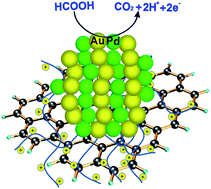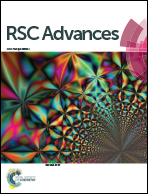Highly active Pd and Pd–Au nanoparticles supported on functionalized graphene nanoplatelets for enhanced formic acid oxidation
Abstract
Pd and Pd–Au nanoparticles supported on poly(diallyldimethylammonium chloride) (PDDA) functionalized graphene nanoplatelets (GNP) have been synthesized by the ethylene glycol reduction method and characterized by transmission electron microscopy (TEM) and electrochemical measurements for formic acid oxidation. TEM analysis shows that the Pd–Au nanoparticles are uniformly distributed on the surface of graphene nanoplatelets with an average particle size of 6.8 nm. The Pd–Au nanoparticles supported on PDDA–xGNP show higher activity for formic acid electro-oxidation than Pd nanoparticles supported on PDDA–xGNP and Pd or Pd–Au supported on traditional Vulcan XC-72 carbon. The higher catalytic activity of Pd–Au/PDDA–xGNP is mainly due to the alloying of Pd with Au. The promotional effect of Au and the absence of continuous Pd sites significantly suppress the poisoning effects of CO, enhancing the catalytic activity for formic acid oxidation and making them promising for direct formic acid fuel cells (DFAFC).


 Please wait while we load your content...
Please wait while we load your content...